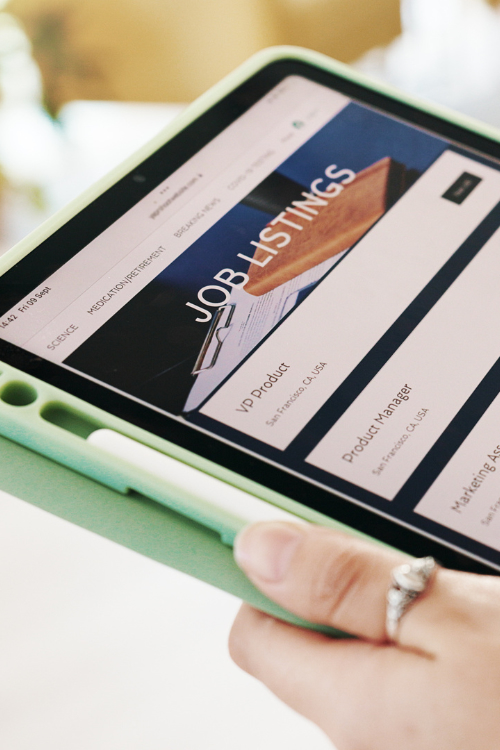The way we work is changing. The traditional workplace, with its nine-to-five office hours and dedicated desk, is becoming a thing of the past. Increasingly, people are working from home, from coworking spaces or even remotely. This shift towards hybrid work has many benefits for both companies and employees. But there are also challenges that need to be overcome to make hybrid work successful. In this blog post, we will explore the benefits, challenges and future of hybrid work.
What is Hybrid Work?
The term hybrid work is used to describe a work model that combines elements of both traditional and remote work. The traditional workplace model is one where employees work in an office, usually from 9am to 5pm. This model is becoming less common as companies are starting to realise the benefits of remote work. Remote work is a model where employees work from home or another locations outside the office like coworking spaces.
Remote work (home office, coworking, mobile working)
Remote work, is a form of work where employees do not have to come to an office to work. They can do their work from home (so-called Homeoffice) or from another location outside the office (coworking or mobile working).
Coworking
Coworking is a typical form of remote work where employees work in a shared space. This can be a good option for people who want to network and collaborate with other professionals. It can also be a good option for companies that intend to save on office space and costs.
It can also mean that companies have set up dedicated coworking spaces in their company that offer their employees a different working environment and also encourage meetings with other teams or departments that can lead to new ideas and innovations.
Hybrid Work
Hybrid work is a model that combines the best of all of these worlds. Employees can work remotely part-time in the Homeoffice or coworking spaces, and then come into the office for meetings and collaboration. This allows employees to maintain a connection with their co-workers, while also enjoying the benefits of remote work.
Before we dive into the benefits of hybrid work, there are also a number of trends why hybrid work is becoming more popular, including:
- The rise of the gig economy
- The increasing popularity of coworking spaces
- The demand of remote work
What are the benefits of Hybrid Work?
There are many benefits to adopting a hybrid work model, both for employees and companies. Let’s have a look at companies first.
For companies, hybrid work can lead to increased efficiency and productivity, as employees can spend more time on task-oriented work when they are in the office. Because there, they can be easily distracted and interrupted. This makes especially sense for remote workers that would otherwise require an office presence, such as customer service or support.
Another vital benefit for companies is, that hybrid work can help reduce costs associated with office space, transportation and employee benefits. They can save money by offering remote work options and by using coworking spaces. And this offering is also potent in terms of recruiting talent.
Because employees feel more empowered when they have the ability to choose where and when they work. This increases satisfaction and motivation. And that makes it ultimately easier for companies to attract and retain talent from a global human resources pool.
Hybrid work also offers employees a number of benefits.
Hybrid work can allow employees to have a better work-life balance. It provides greater flexibility and freedom when it comes to hours and working from home. When employees can work from home, they can take care of their personal responsibilities without having to worry about their job. It also means greater flexibility and control over their work schedule. And employees save on time getting to work or commuting, more time can be spent with family and friends, which adds to a work-life balance.
This in turn can also lead to improved morale. When employees feel like they have a good work-life balance, they are more likely to be happy and satisfied with their job. This also helps employees greatly to reduce stress levels, as they can manage their time more efficiently.
Another major benefit of hybrid work is, that it can also lead to increased productivity. When employees are working from home, they can focus on their work without distractions. This can also lead to an increase in creativity. Because when employees can work in a more relaxed environment, the likeability of being more creative and innovative rises.
Employees will enjoy a more flexible working arrangement, with the ability to work from home, the traditional office or coworking spaces as needed. This flexibility again allows employees to find the best balance for their work and their life. Coworking spaces can lead to a more engaging work environment, while meeting other professionals of different companies or industries.
Overall, the hybrid work model enhances the employee experience by giving them more freedom and flexibility. It allows employees to connect with people from all over the world and gives them opportunities for career growth as they can work in different locations and industries. In the same fashion, that means easier access to networking chances, as they can connect with people from all over the world.
Challenges of Hybrid Work
However, there are also challenges associated with hybrid work. Let’s look again first at the organisational side.
The main challenges of hybrid work are communication and coordination. When employees are working in different locations, it can be difficult to communicate effectively with them and hence could lead to communication problems.
Hybrid work can be difficult to manage remote and in-office employees. It can be difficult to make sure that everyone is on the same page and that everyone is working towards the same goal. This can lead to confusion and frustration, especially if tasks are not properly coordinated. When employees are working remotely, it easily can lead to misunderstandings and miscommunication with their coworkers and supervisors.
Also, trust is a big issue when it comes to hybrid work. It can be difficult to track employee productivity when they are not in the office. Employers need to trust that their employees are working even when they are not in the office. Employees also have to trust their employers. When there is no trust between both parties, hybrid work is very likely to fail.
Finally, some companies may not have the infrastructure in place to support hybrid work, so it is obligatory to check this precondition.
Employees
On the employee side, on big issue is that they might feel isolated if they are working from home. They may feel disconnected from their colleagues, miss the social interaction that comes with working in an office, or not feel like they are a part of the team. In the same sense, they may feel like they are not getting the same opportunities as their colleagues who are working in the office. They may feel like they are missing out on important projects or meetings.
What is a benefit on the one side could also be a challenge—employees may have difficulty focusing if they are working in a coworking space or when working from home. It could also be difficult to transition between home and office environments. And they may be distracted by the people around them and the unfamiliar environment, which raise stress-levels again. Also, if you work from home, employees need to find balance between work and home life.
Hybrid work could also lead to job insecurity for employees. When employees are working remotely, there is a risk that their job could be eliminated if the company decides to downsize or outsource their operations. Working from home mostly results into limited networking opportunities.
How can companies contribute to Hybrid work in the future?
Many companies are hesitant to adopt a hybrid work model because of the challenges it presents. However, there are ways that companies can contribute to the future of hybrid work.
1. Organisation
Companies can provide their employees with the tools they need to work remotely.
The base setup would be a laptop and access to the internet. It also means, employers should ensure that employees have the necessary tools to communicate effectively, such as video conferencing and messaging apps. Other resources might include noise-cancelling headphones or a work-from-home kit.
2. Communication
Bosses should make a concerted effort to promote communication and coordination between employees. In this regard, employees should take the initiative to stay connected with their colleagues, even if they are working remotely.
3. Trust and Expectations
One way to build trust is to set clear expectations for employees. Employers should make sure that employees know what is expected of them, how they will be evaluated, and how they need to be available. Employees should also be honest with their employers about their work schedule and productivity.
4. Culture of communication and hybrid work
Another way to build trust is to create a culture of communication. Employers should encourage employees to communicate with each other, both in-person and online. This will help employees feel connected to each other, even if they are not in the same office.
Companies should also create a culture that supports hybrid work. This includes promoting work-life balance and encouraging employees to take advantage of the flexibility that hybrid work provides.
5. Coworking Spaces
Companies can create or rent coworking spaces for their employees. This allows employees to work in a collaborative environment and fosters creativity and innovation.
There are also a few key things that employees can do to make the transition to hybrid work successful:
- Set clear boundaries between work and home life.
- Create a comfortable and productive home office space.
- Stay connected with colleagues and build a strong support network.
- Be flexible and adaptable to change.
By taking these steps, companies and their teams can contribute to the future of hybrid work and make it a success.
How BMW and Siemens adopt Hybrid Work
BMW is one of the pioneers of a hybrid working model in Germany. As early as 2013, a company agreement on mobile working was concluded, ensuring that BMW was a pioneer for the entire industry. The concept of mobile working also won gold at the German Works Council Award 2014, which justifies the statement of BMW works council chair Manfred Schoch: "If someone looks after their demented mother in an old people's home during the day and works on their e-mails while she is asleep, that is working time at BMW. If someone works on the train, that is working time at BMW. The issue of mobile working at BMW is therefore a step further than Homeoffice.
Employees who do not necessarily have to work permanently at the site, e.g. in production or in research and development (R&D), are given the option of mobile working. Since its introduction in 2014, mobile working has steadily increased, which of course jumped with the pandemic. BMW recognised early on that flexibility and agility would become crucial competitive factors of the future. With ConnectedWorks, the BMW Group enables flexible working and a modern work-life balance.
"Ideas and innovations are created primarily through personal exchange. Attractive working environments are therefore a key success factor for us - complemented by hybrid and digital collaboration models, " says Ilka Horstmeier, HR Director at BMW AG.
Siemens is also making a strong case for mobile working. In the wake of the pandemic, they established 2 to 3 days per week as the global standard for mobile working called the "New Normal Working Model".
"Mobile working explicitly does not only refer to the home office. Rather, the employee - in consultation with the manager - should choose the work location where he or she is most productive. The hybrid working model therefore explicitly includes working environments such as co-working offices. Time spent in the office should complement mobile working in a meaningful way."
Mobile working already existed at Siemens before the pandemic. But the new "New Normal Working Model" affects more than 140,000 employees at over 125 locations in 43 countries and cements a hybrid working model at this traditional company.
The next innovative leap came in June 2022. Siemens is expanding its workplace solution Comfy with tools to support hybrid working models. This specifically addresses the challenges we've covered before - such as the lack of social contact, difficulties in building and maintaining a network, and the lack of collaboration opportunities.
Thanks to this solution, employees can see if and where their colleagues are working. This also makes it possible to coordinate hybrid working hours with them, and to organise time in the office efficiently, or when it comes to workspace reservation or meeting planning.
"Our new 'Flexible Spaces' features make space reservations even easier and create opportunities for collaboration and socialising. This allows companies to reduce vacant office space and foster a sense of community," said Stefan Schwab, CEO of Comfy | Enlighted.
This solution is a significant step towards making Hybrid Work a real reality, and thus exploiting the many benefits it enables.
Conclusion - Why Hybrid Work represents a realistic work scenario for the future
Looking ahead, it is clear that hybrid work is here to stay. With the rise of technology, there are more opportunities for employees to work remotely. This means that companies can save on costs such as office space and transportation. Additionally, employees will have greater flexibility and freedom when it comes to their work schedule. This will enhance the employee experience and make it easier for companies to attract and retain talent.
As more and more companies adopt a hybrid work model, the challenges that come with it will become less and less. On the other side, the benefits of hybrid work will become more and more evident. As the world becomes increasingly connected, the hybrid work model will become more and more popular. The future of hybrid work is likely to be more flexible and diverse, with a greater focus on employee experience. As the world of work continues to change, hybrid work will become an increasingly important part of the way we work.
By offering employees the flexibility to work from home or in a coworking space, they can create their ideal working environment. This can lead to increased productivity and satisfaction. Additionally, hybrid work can help employees strike a better balance between their work and personal lives. It's a win-win for both employees and employers, and the future of work is looking more hybrid than ever.










.png)




